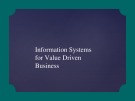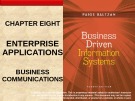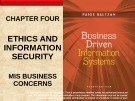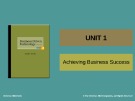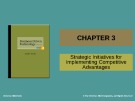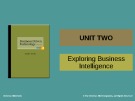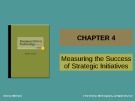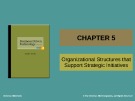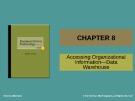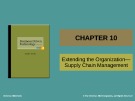
Lecture Business driven information systems
-
In this chapter, students will be able to understand: How business make profit (value chain), how is create added value, how business make decision (organizational pyramid), how is help in decision making process.
 56p
56p  larachdumlanat125
larachdumlanat125
 01-12-2020
01-12-2020
 17
17
 5
5
 Download
Download
-
Chapter 1 - Management information systems: Business driven MIS. Learning objectives of this chapter include: Describe the information age and the differences among data, information, business intelligence, and knowledge; identify the different departments in a company and why they must work together to achieve success; explain systems thinking and how management information systems enable business communications.
 41p
41p  koxih_kothogmih6
koxih_kothogmih6
 23-09-2020
23-09-2020
 24
24
 3
3
 Download
Download
-
Chapter 3 - Ebusiness: Electronic business value. Learning objectives of this chapter include: Compare disruptive and sustaining technologies, and explain how the Internet and WWW caused business disruption; describe ebusiness and its associated advantages; compare the four ebusiness models; describe the six ebusiness tools for connecting and communicating.
 56p
56p  koxih_kothogmih6
koxih_kothogmih6
 23-09-2020
23-09-2020
 19
19
 5
5
 Download
Download
-
Chapter 5 - Infrastructures: Sustainable technologies. After studying this chapter you will be able to: Explain MIS infrastructure and its three primary types, identify the three primary areas associated with an information MIS infrastructure, describe the characteristics of an agile MIS infrastructure, identify the environmental impacts associated with MIS.
 40p
40p  koxih_kothogmih6
koxih_kothogmih6
 23-09-2020
23-09-2020
 31
31
 4
4
 Download
Download
-
Chapter 6 - Data: Business intelligence. Learning objectives of this chapter include: Explain the four primary traits that determine the value of information; describe a database, a database management system, and the relational database model; identify the business advantages of a relational database; explain the business benefits of a data-driven website.
 57p
57p  koxih_kothogmih6
koxih_kothogmih6
 23-09-2020
23-09-2020
 31
31
 4
4
 Download
Download
-
Chapter 7 - Networks: Mobile business. The goals of this chapter are: Explain the five different networking elements creating a connected world, identify the benefits and challenges of a connected world, describe the different wireless network categories, explain the different wireless network business applications, identify the benefits and challenges of business mobility.
 48p
48p  koxih_kothogmih6
koxih_kothogmih6
 23-09-2020
23-09-2020
 24
24
 4
4
 Download
Download
-
Chapter 8 - Enterprise applications: Business communications. When you finish this chapter, you should: Explain integrations and the role they play in connecting a corporation, describe supply chain management along with its associated benefits and challenges, describe customer relationship management along with its associated benefits and challenges, describe enterprise resource planning along with its associated benefits and challenges.
 62p
62p  koxih_kothogmih6
koxih_kothogmih6
 23-09-2020
23-09-2020
 34
34
 4
4
 Download
Download
-
Chapter 9 - Systems development and project management: Corporate responsibility. Learning objectives of this chapter include: Describe the seven phases of the systems development life cycle, summarize the different software development methodologies, explain project management and identify the primary reasons projects fail, identify the primary project planning diagrams, identify the three different types of outsourcing along with their benefits and challenges.
 53p
53p  koxih_kothogmih6
koxih_kothogmih6
 23-09-2020
23-09-2020
 17
17
 4
4
 Download
Download
-
Chapter 2 - Decisions and processes: Value driven business. The goal is for you to learn: Explain the importance of decision making for managers at each of the three primary organization levels along with the associated decision characteristics; define critical success factors (CSFs) and key performance indicators (KPIs), and explain how managers use them to measure the success of MIS projects.
 57p
57p  koxih_kothogmih6
koxih_kothogmih6
 23-09-2020
23-09-2020
 23
23
 3
3
 Download
Download
-
Chapter 4 - Ethics and information security: MIS business concerns. After studying this chapter you will be able to: Explain the ethical issues in the use of information technology, identify the six epolicies organizations should implement to protect themselves, describe the relationships and differences between hackers and viruses, describe the relationship between information security policies and an information security plan.
 46p
46p  koxih_kothogmih6
koxih_kothogmih6
 23-09-2020
23-09-2020
 36
36
 3
3
 Download
Download
-
The learning objectives for Chapter 1 include: Compare management information systems (MIS) and information technology (IT); describe the relationships among people, information technology, and information; identify four different departments in a typical business and explain how technology helps them to work together; compare the four different types of organizational information cultures and decide which culture applies to your school.
 23p
23p  tangtuy11
tangtuy11
 20-05-2016
20-05-2016
 48
48
 3
3
 Download
Download
-
Chapter 3 - Strategic initiatives for implementing competitive advantages. The learning objectives for this chapter include: List and describe the four basic components of supply chain management, explain customer relationship management systems and how they can help organizations understand their customers, summarize the importance of enterprise resource planning systems, identify how an organization can use business process reengineering to improve its business.
 25p
25p  tangtuy11
tangtuy11
 20-05-2016
20-05-2016
 44
44
 2
2
 Download
Download
-
Chapter 6 - Valuing organizational information. The goals of this chapter are: Describe the broad levels, formats, and granularities of information; differentiate between transactional and analytical information; list, describe, and provide an example of each of the five characteristics of high quality information; assess the impact of low quality information on an organization and the benefits of high quality information on an organization.
 19p
19p  tangtuy11
tangtuy11
 20-05-2016
20-05-2016
 44
44
 4
4
 Download
Download
-
Chapter 4 - Measuring the success of strategic initiatives. The learning objectives for this chapter include: Compare efficiency IT metrics and effectiveness IT metrics, list and describe five common types of efficiency IT metrics, list and describe four types of effectiveness IT metrics, explain customer metrics and their importance to an organization.
 22p
22p  tangtuy11
tangtuy11
 20-05-2016
20-05-2016
 41
41
 2
2
 Download
Download
-
Chapter 5 - Organizational structures that support strategic initiatives. The learning objectives for this chapter include: Compare the responsibilities of a chief information officer (CIO), chief technology officer (CTO), chief privacy officer (CPO), chief security officer (CSO), and chief knowledge office (CKO); explain the gap between IT people and business people and the primary reason this gap exists; define the relationship between information security and ethics;...
 27p
27p  tangtuy11
tangtuy11
 20-05-2016
20-05-2016
 42
42
 2
2
 Download
Download
-
Chapter 8: Accessing organizational information - data warehouse. In this chapter students will be able to: Describe the roles and purposes of data warehouses and data marts in an organization, compare the multidimensional nature of data warehouses (and data marts) with the two-dimensional nature of databases, identify the importance of ensuring the cleanliness of information throughout an organization,...
 26p
26p  tangtuy11
tangtuy11
 20-05-2016
20-05-2016
 45
45
 3
3
 Download
Download
-
Chapter 7 - Storing organizational information - Databases. Define the fundamental concepts of the relational database model, evaluate the advantages of the relational database model, compare relational integrity constraints and business-critical integrity constraints, describe the benefits of a data driven website, describe the two primary methods for integrating information across multiple databases.
 25p
25p  tangtuy11
tangtuy11
 20-05-2016
20-05-2016
 47
47
 2
2
 Download
Download
-
Chapter 9 - Enabling the organization - decision making. After studying this chapter you will be able to: Define the systems organizations use to make decisions and gain competitive advantages, describe the three quantitative models typically used by decision support systems, describe the relationship between digital dashboards and executive information systems, list and describe four types of artificial intelligence systems.
 27p
27p  tangtuy11
tangtuy11
 20-05-2016
20-05-2016
 42
42
 2
2
 Download
Download
-
Learning objectives of this chapter include: List and describe the components of a typical supply chain, define the relationship between decision making and supply chain management, describe the four changes resulting from advances in IT that are driving supply chains, summarize the best practices for implementing a successful supply chain management system.
 21p
21p  tangtuy11
tangtuy11
 20-05-2016
20-05-2016
 44
44
 3
3
 Download
Download
-
Chapter 12: Integrating the organization from end to end - Enterprise resource planning. The learning objectives for this chapter include: Describe the role information plays in enterprise resource planning systems; identify the primary forces driving the explosive growth of enterprise resource planning systems; explain the business value of integrating supply chain management, customer relationship management, and enterprise resource planning systems.
 22p
22p  tangtuy11
tangtuy11
 20-05-2016
20-05-2016
 38
38
 3
3
 Download
Download
CHỦ ĐỀ BẠN MUỐN TÌM








